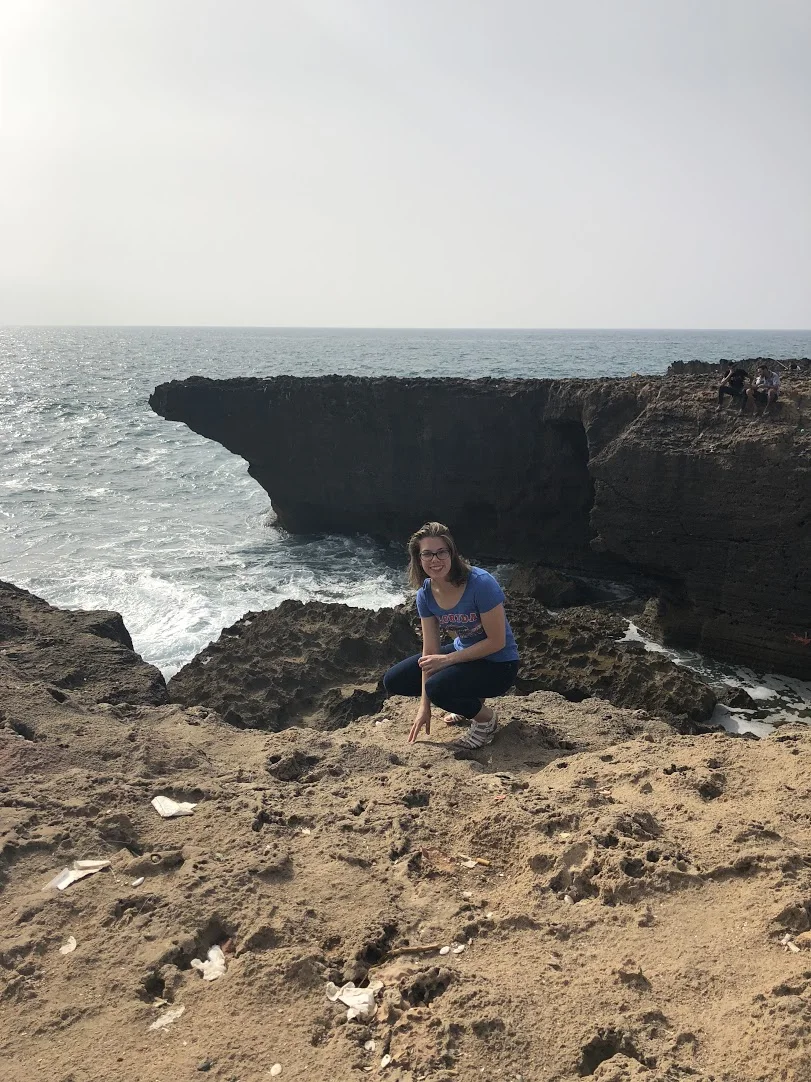"Sheebat!" by Gwenyth Szabo
I made it! Every day for the first two weeks in Morocco has been accompanied by an “I can’t believe I’m in Morocco” to at least one of the people in my program. The first night was a combination of nervousness and jetlag, but I immediately relaxed after meeting my host family. I am fortunate to be living five minutes from the beach, and my host mother took my roommate and me there the very first night. The Rabat beach is beautiful, and witnessing it for the first time at night was breathtaking.
Because Rabat is a coastal city, the weather is very pleasant, and there is a nice ocean breeze felt throughout the city. One of the first questions everyone from home asked me was: “Is it hot there”. It is hot, but it’s not nearly as bad as Washington D.C., which had 90-100 degrees Fahrenheit days this past summer and an unbearable humidity.
Visited Rabat beach the first day with my group during orientation. Rabat beaches can have sand, but the area near my homestay is comprised of volcanic rock. Photo credit: Julia Slawinski, 2018
As I slowly adjust to Moroccan culture, it’s easy to perceive the surface differences between Morocco and the United States, such as the environment and language, but one of my favorite parts of travelling is trying new food! I’m very grateful to be living with a host family and have the opportunity to share home-cooked meals with them.
Typically, my roommate and I eat breakfast early before heading to school. Breakfast in Morocco is the smallest meal of the day and usually consists of eggs (hard-boiled with cumin and salt or scrambled), yogurt, and bread with cheese, apricot jelly, or butter. Water, tea, or coffee are drink options.
The most common and popular tea in Morocco is mint. It’s served in small glasses after pouring the first glass back into the pot. My first remark was that the tea was very sweet, but this was not surprising after learning how the tea is prepared. One of the key ingredients, aside from a spoonful of mint leaves, is a generous sugar cube. After adding boiling water, the tea is left to steep for two to four minutes. Once the tea is ready, it’s accompanied by cookies or candies.
I have a giant sweet tooth, so I was excited to discover that Moroccans do as well. At the medina (bazaar), there are shops at every corner selling sugar cane juice and Moroccan sweets, and when my group travelled to the beach in Skhirat, beignets, or donuts, and ice cream were being sold on along the beach.
My first home-cooked breakfast in Morocco. Photo credit: Szabo, 2018
A classic Moroccan teapot with the ingredients for mint tea inside; the white lump is all sugar! Photo credit: Szabo, 2018
Dinner is also a smaller meal and eaten very late; however, this does not mean I go to bed hungry. In fact, the first word I learned in Darija (the spoken Arabic dialect in Morocco) was the word for full (sheebat).
One of the most common ways to serve dinner is in a tajin, which is a clay plate including a triangle cover to keep the food warm. Dinner includes a main dish with a small salad and bread. Moroccan bread is baked flat in a special oven then cut into large pieces. Salads can include beets, carrots, cucumbers, tomatoes, and lettuce. Potatoes are often served with cooked zucchini or carrots, but they can also be served in the salads, similar to the United States.
Typical Moroccan dinner, including chicken, potatoes, and cooked zucchini with a small salad. Photo credit: Szabo, 2018
After an eventful week of orientation, it was time for our group to experience our first Moroccan tradition: sharing couscous with our host families. Every Friday, Moroccans gather with extended family to eat couscous for lunch. Lunch is the largest meal of the day, and my host mother spent all of Thursday evening preparing the vegetables, potatoes, and meat. When my roommate and I arrived home from our last day of orientation, a large dish of couscous was waiting with a spoon for each member of the family. Two of the family members did not use spoons; instead, because of the couscous’ sticky consistency, they used their hands to roll the potatoes and vegetables into the couscous and create almost a couscous meatball to eat with their hands. It was the best couscous I’ve ever had, and I felt honored to be able to partake in a Moroccan family tradition.
The couscous meal my host mom prepared for our traditional, giant couscous lunch. Photo credit: Szabo, 2018






